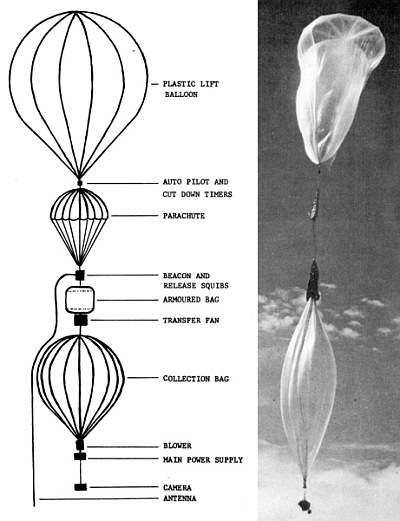Purpose of the flight and payload description
The objective of this flight was to collect air samples as part of Project GRAB BAG, a program conducted in mid 50's by the US Air Force for the stratospheric monitoring of soviet tests of nuclear weapons. The collection system was developed by General Mills, Inc. and consisted of four major components: a lift stratospheric balloon, a collection bag, an armored vessel, and a control unit. The key concept behind the program was to suspend an uninflated envelope beneath a large helium filled balloon, and carry the envelope to high altitude to fill it with ambient air. An autopilot would then initiate the descent of the entire system to recover the samples on ground. The image at left shows a schematic description of the sampling system along with one of the balloons during descent (click to enlarge).
Description of the system
The collection bag or sample balloon was a large balloon fabricated of the same material as the lift balloon. Two sizes of bags were used, depending on the collection altitude: 47.5 feet in diameter at altitudes above 80,000 feet, and 34.6 feet in diameter at lower altitudes. The base of the bag was modified to take a cylindrical fitting that was fitted with a collection blower of the centrifugal type, powered by a 24-volt direct-current motor. The blower would operate at the ceiling altitude of 80,000 feet for about two hours to fill the sample balloon with about 33,000 cubic feet of air. At this point, an auto pilot would release a predetermined amount of helium from the lifting balloon and initiate the descent of the entire system at a rate of about 400 feet per minute. As the system descended to about 10,000 feet, an axial fan located at the top of the sample envelope would be activated to transfer the air sample into a flexible armored vessel located just above the sample balloon.
The non-rigid armored vessel was designed to withstand the rigors of most landings and preserve the air sample. It consisted of three nested cylinders of flexible materials that, from the outside to the inside, were: a tough outer layer of plasticized nylon; an intermediate layer of woven nylon with very high tear strength, and; an innermost cylinder of polyethylene film that would serve as a gas barrier for the air sample. At takeoff the armored vessel hung in a deflated form around the steel cable and below an open parachute that would provide braking of the system descent if the rate exceeded about 2000 feet per minute or to prevent free fall of the equipment in case of failure. The transfer of the sample to the vessel during descent required a short period of time after which a valve at the base of the armored vessel was sealed.
All the operation of the different components of the system were managed by the electronic control unit. It consisted of a power supply, master control unit, and barograph, all housed in a large, insulated, red bag. An upward-viewing sequence camera suspended below the control unit provided a record of the expansion of the lift balloon and the deployment of the collection bag. The electronic control unit transmitted via telemetry the altitude of flight and key steps in the flight sequence, like starting of the blower and axial fan, auto pilot descent, rate of descent and finally the arming of the explosive cut down devices. When the control unit contacted ground, explosive devices severed the connection between the lifting balloon and the parachute leading to its collapse thus ending the flight.
During the entire flight, a recovery crew in an helicopter followed the course of the balloon visually or tracking the signals generated by a radio beacon. Once in the landing site they transferred the air sample with a four-stage compressor from the armored vessel to high-pressure cylinders for shipment to the laboratory. The air samples were then analyzed for the presence of specific isotopes that provided information of probable size, yield, and composition of the nuclear weapons detonated and the distribution of radioactive elements generated.
Near 1000 Grab Bag flights were performed until the program termination in 1958. A detailed history and complete flight record of the program can be found in the first link of external references below.
Details of the balloon flight
Balloon launched on: 6/15/1956
Launch site: Panama Channel Zone
Balloon launched by: 1110th Balloon Activities Squadron, USAF
Balloon manufacturer/size/composition: Zero Pressure Balloon
End of flight (L for landing time, W for last contact, otherwise termination time): ??/??/1956
External references
- History of the development and operation of GRAB BAG Stratopedia, the balloon encyclopedia
- Stratospheric Carbon-14, Carbon Dioxide, and Tritium Science 4 September 1959: Vol. 130 no. 3375 pp. 542-552
7397If you consider this website interesting or useful, you can help me to keep it up and running with a small donation to cover the operational costs. Just the equivalent of the price of a cup of coffee helps a lot.


